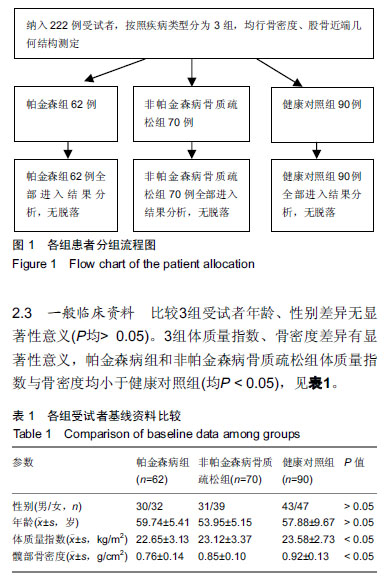中国组织工程研究 ›› 2019, Vol. 23 ›› Issue (24): 3829-3833.doi: 10.3969/j.issn.2095-4344.1232
• 骨与关节生物力学 bone and joint biomechanics • 上一篇 下一篇
股骨近端几何结构结合骨密度预测帕金森病髋部骨折的风险
王武华1,刘旭东2,胡 凌3
- 1南昌大学抚州医学院影像教研室,江西省抚州市 344000;2南昌大学抚州医学院,江西省抚州市 344000;3抚州市第一人民医院影像二科,江西省抚州市 344000
Prediction of hip fracture in Parkinson’s disease with the combination of geometric structure of proximal femur and bone mineral density
Wang Wuhua1, Liu Xudong2, Hu Ling3
- 1Department of Radiology, Fuzhou Medical College of Nanchang University, Fuzhou 344000, Jiangxi Province, China; 2Fuzhou Medical College of Nanchang University, Fuzhou 344000, Jiangxi Province, China; 3Second Department of Radiology, the First People’s Hospital of Fuzhou, Fuzhou 344000, Jiangxi Province, China
摘要:
文章快速阅读:
.jpg)
.jpg)
文题释义:
帕金森病:又名震颤麻痹,是最常见的神经退行性疾病之一。多见于中老年,呈隐袭性发病,50岁以上的患者占总患病人数的90%以上,慢性进展性病程,5-8年后约半数患者需要帮助。震颤、强直、运动不能(或运动减少)与姿势和平衡障碍为其主要表现。
髋部骨折:当机械压力超过局部骨所能承受的强度时,就会发生骨折。在骨质疏松症患者中股骨颈逐渐发生退行性变,皮质骨薄而疏松,骨小梁稀疏,张力骨小梁及压力骨小梁减少尤其明显,从而不能承受较大的应力和变形。
摘要
背景:帕金森病患者由于跌倒的风险较高且骨密度较低,骨折风险增加,了解髋部骨折相关危险因素及预测风险性至关重要。
目的:测量帕金森患者骨密度与股骨近端几何结构变化,预测髋部骨折风险。
方法:选择抚州市第一人民医院帕金森病患者62例作为帕金森病组,70例非帕金森病骨质疏松者作为非帕金森病骨质疏松组,以90例年龄和性别匹配的健康人群作为健康对照组。所有受试者对试验方案均知情同意,且得到抚州市第一人民医院伦理委员会批准。采用双能X射线骨密度仪及自带的髋部结构分析软件测量骨密度与股骨近端几何结构参数,股骨近端几何结构参数和骨密度的相关性采用Pearson相关分析。
结果与结论:①比较3组受试者股骨颈干角、截面力矩,差异均无显著性意义(P > 0.05);②帕金森病组截面面积、骨皮质厚度小于非帕金森病骨质疏松组及对照组,屈曲应力比大于非帕金森病骨质疏松组及对照组,差异均有显著性意义(P < 0.05);③骨密度与股骨颈、转子间截面面积、骨皮质厚度呈高度正相关(P < 0.01),与屈曲应力比呈高度负相关(P < 0.01),与股骨颈干角、截面力矩无相关性(P均>0.05);④提示帕金森患者骨密度减低,股骨近端结构发生改变,表现为骨截面面积、骨皮质厚度降低,屈曲应力比增高,增加帕金森病患者髋部骨折风险;髋部骨折发生与髋部骨密度及股骨近端几何结构改变有关。
中国组织工程研究杂志出版内容重点:人工关节;骨植入物;脊柱;骨折;内固定;数字化骨科;组织工程
ORCID: 0000-0002-5558-8900(王武华)
中图分类号:
R459.9



.jpg)